Learn how to cut cabbage in 3 different ways with this simple step-by-step tutorial. Whether you’re looking for wedges, steaks, or shreds, you’ll feel like a pro by the time you’re done here!
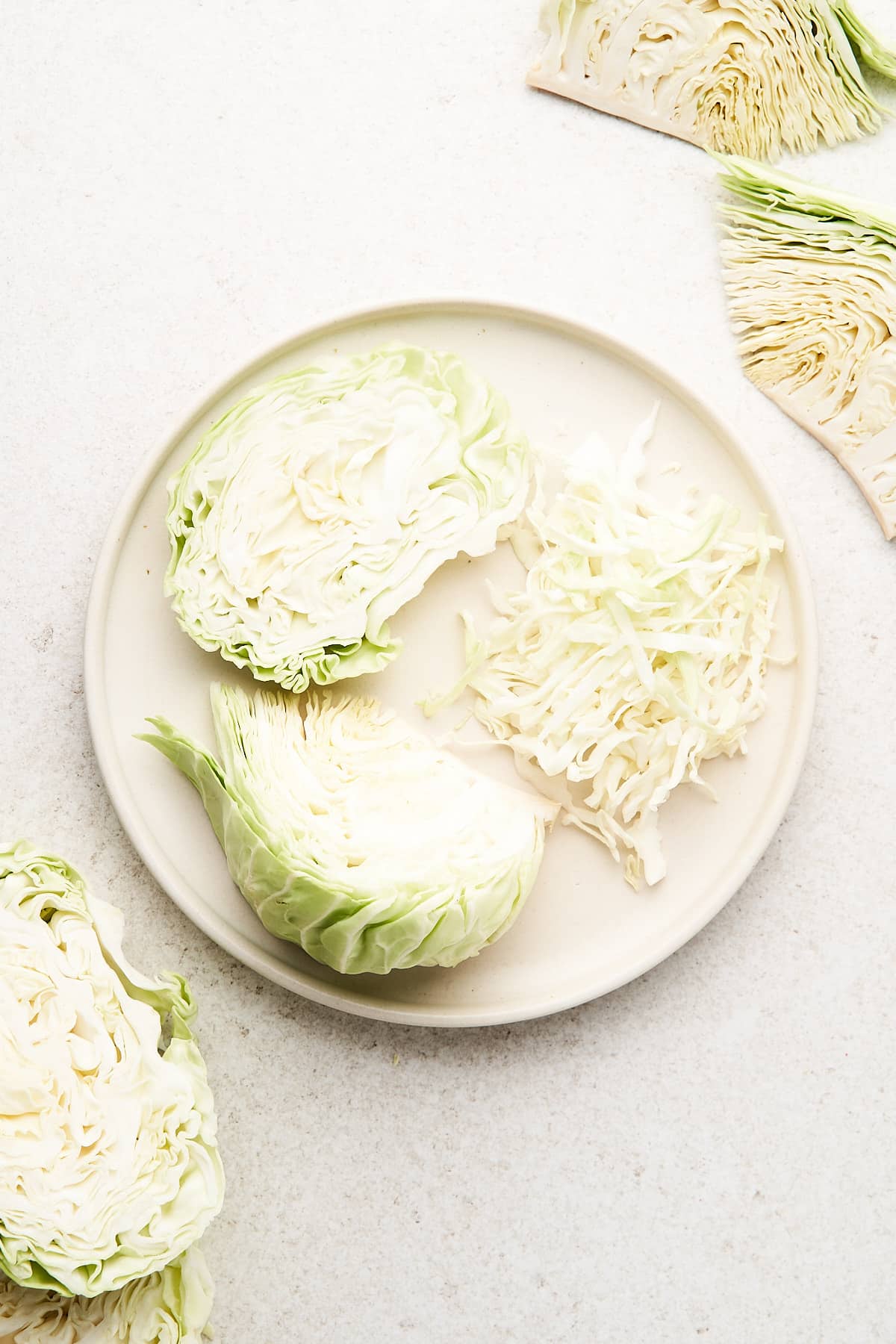
What is cabbage?
Categorized in the same family as Brussels sprouts, broccoli, and kale, cabbage is considered a cruciferous vegetable. There are different varieties like red, green, savoy, or napa, but the most common are red and green.
In its raw form, cabbage is quite crunchy and slightly bitter. Once cooked down, it really softens up and provides a milder, sweeter flavor. With how versatile this inexpensive (and often underrated) vegetable is, it’s a must for any home cook to learn how to cut cabbage!
How to cut cabbage
Understanding how to cut cabbage may seem like a daunting task, but this vegetable doesn’t bite! It’s extremely straightforward once you get the hang of it. Today, I’m outlining 3 different methods that come in handy for a wide variety of recipes.
So, grab a non-slip cutting board, a chef’s knife, or a mandolin, and let’s get to cutting!
Prepare the cabbage
Before anything else, remove the outermost leaves from the head of the cabbage, especially if they appear bruised, wilted, or discolored. Give the cabbage a rinse, then dry it thoroughly.
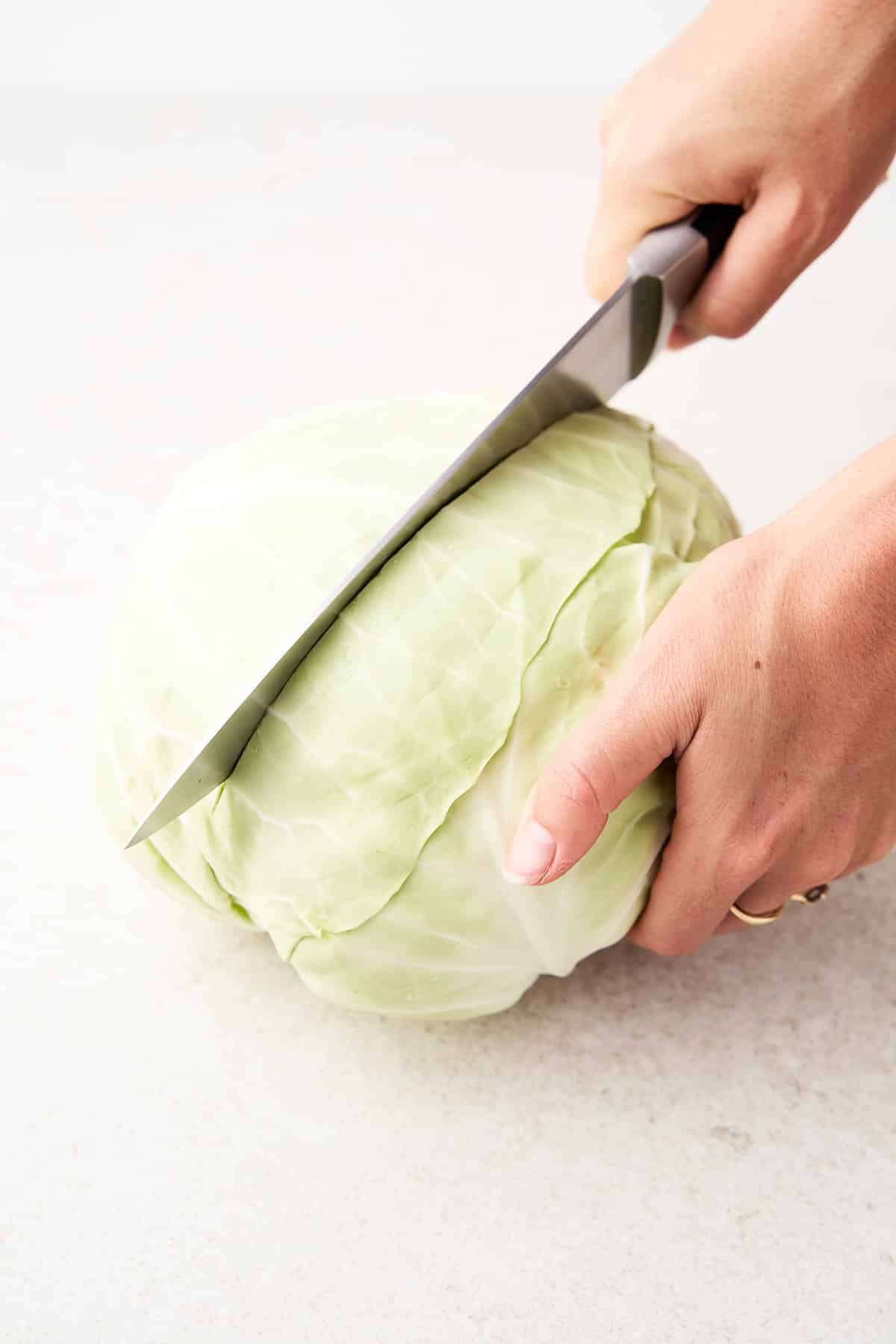
Option 1: Cabbage steaks
Stand the cabbage upright with the stem side down, making sure it’s not wobbling around. If need be, trim the stem slightly to create a flat surface. Firmly grip the cabbage with your non-dominant hand, then make slices about ¾ – 1 inch thick.
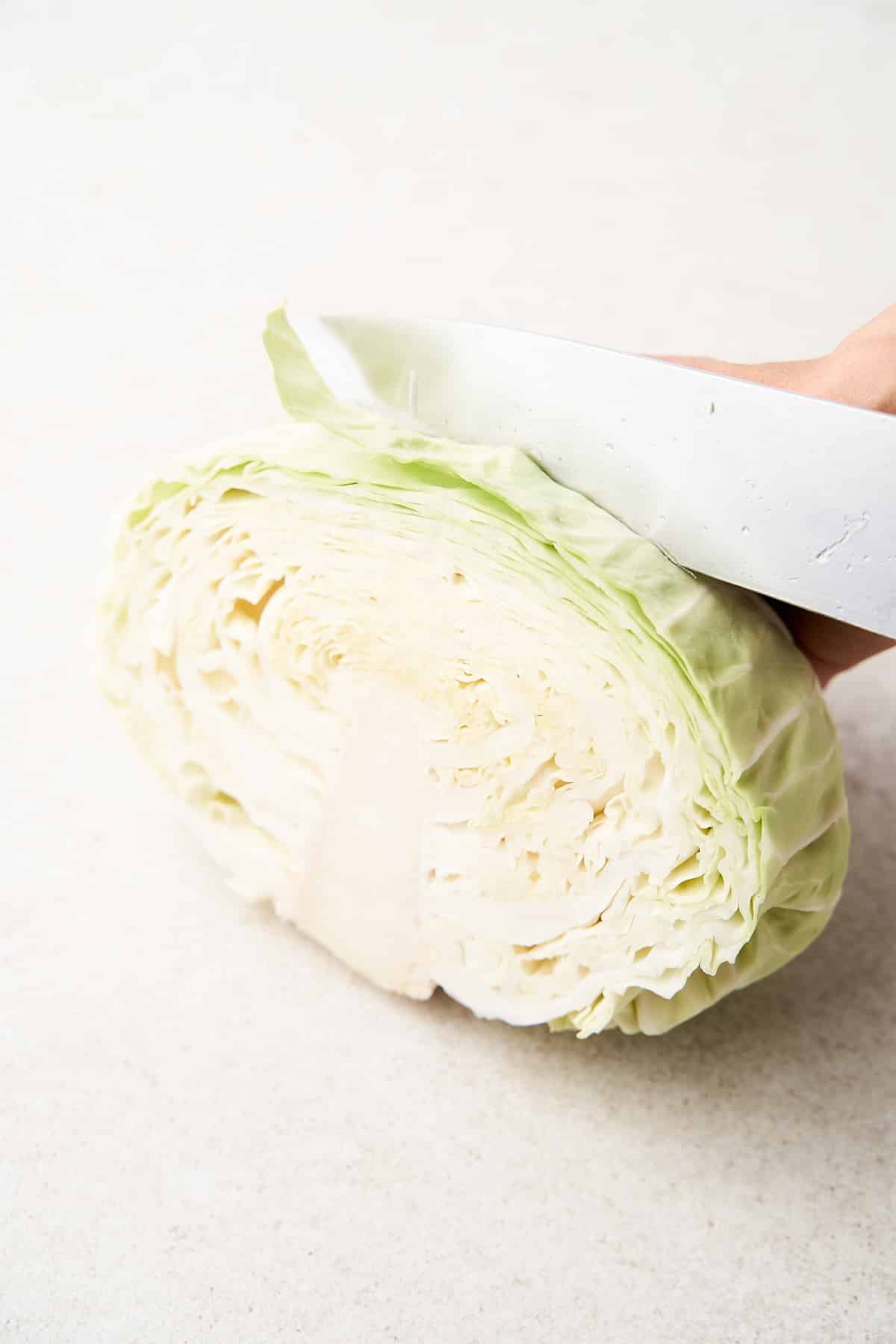
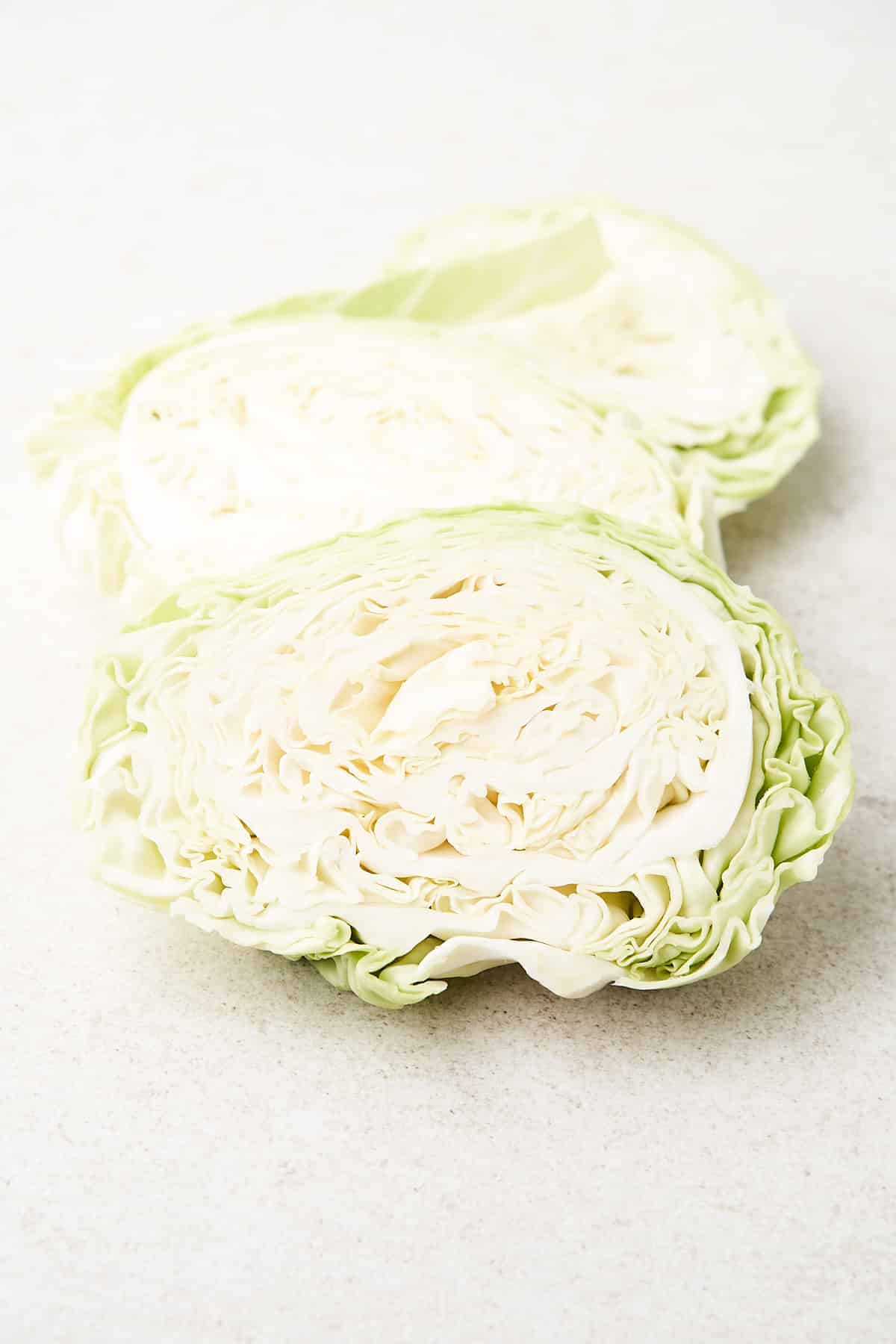
Season cabbage steaks with olive oil and your favorite herbs and spices, then roast the steaks for a delicious centerpiece at any meal. Here’s my favorite cabbage steak recipe!
Option 2: Cabbage wedges
Again, stand the cabbage upright with the stem side down. Slice it down the middle into two equal halves. Turn each half over, then slice it in half again to make quarters. If your cabbage is large, cut the quarters one more time to make smaller wedges.
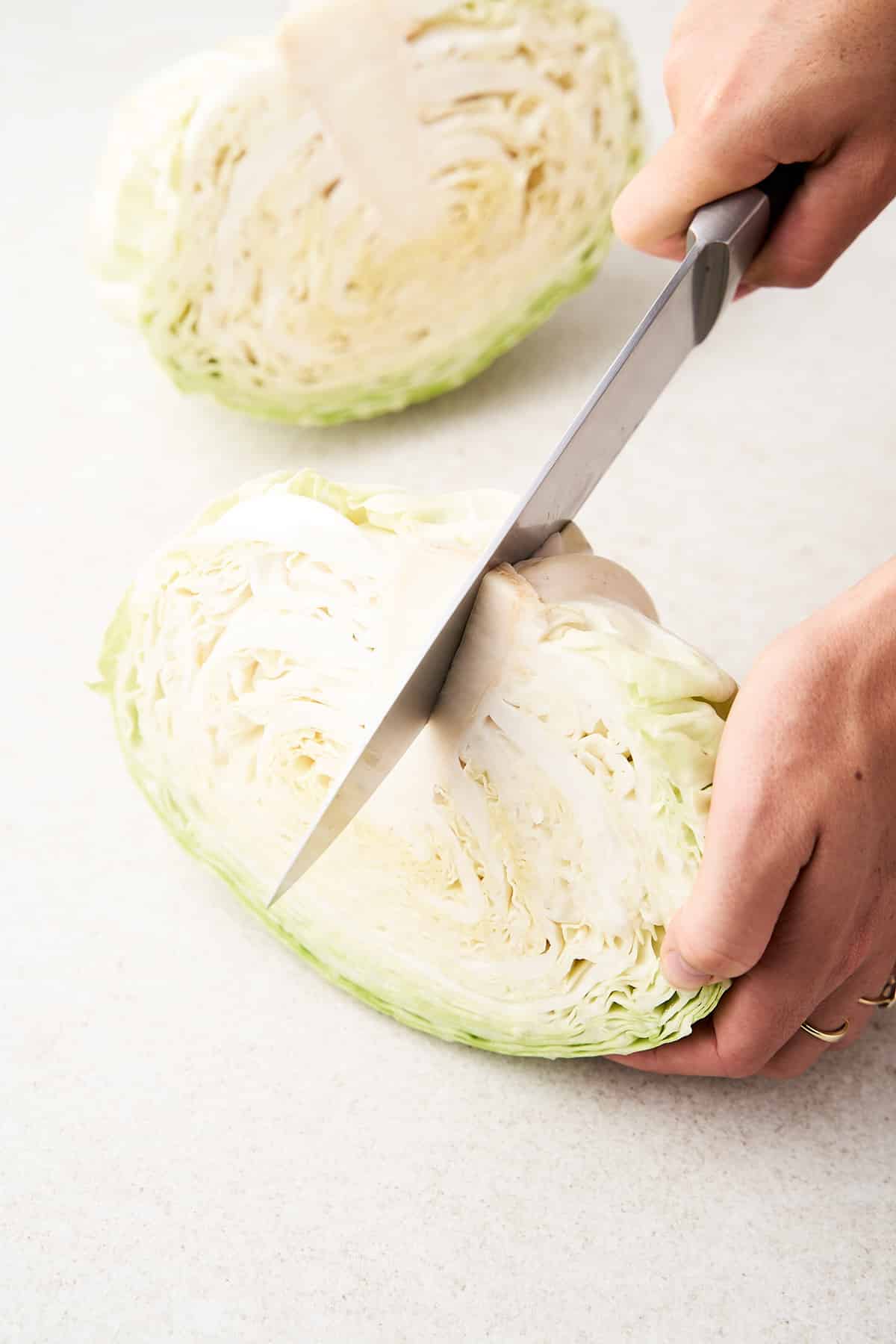

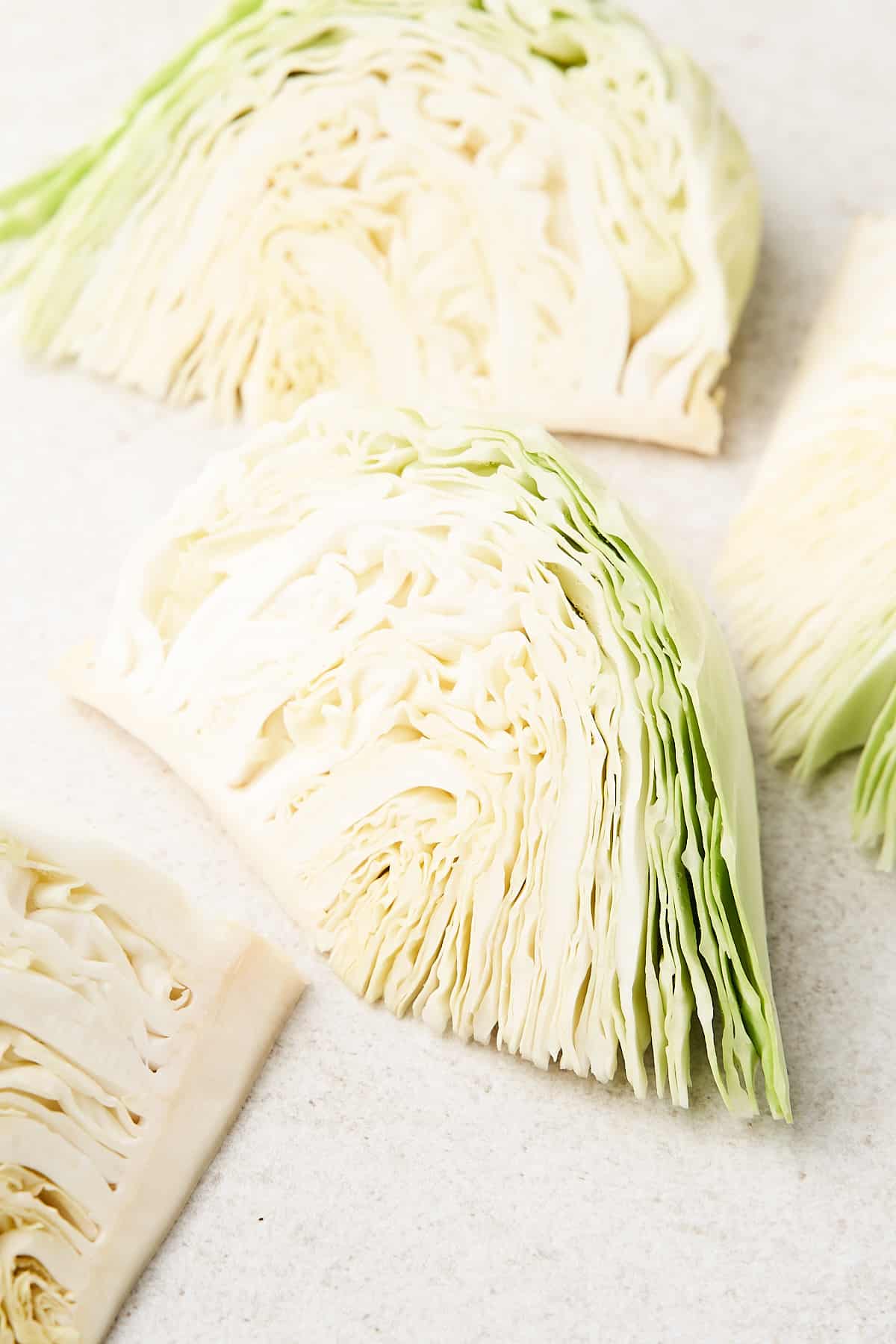
To remove the core, keep each wedge on a flat side. Make an angled cut with your knife, ensuring you don’t cut all the way through the core (it will help keep the leaves together). This method is great for our air fryer cabbage recipe!
Option 3: Shredded cabbage
Repeat the same process as the cabbage wedges. Once you’ve removed the core, make thin perpendicular slices all the way along each cabbage quarter. Make the slices fairly thin, around ⅛ – ¼ inch thick for recipes like coleslaw or sauerkraut. For stir-fries and the like, you can cut them around ½-inch thick.
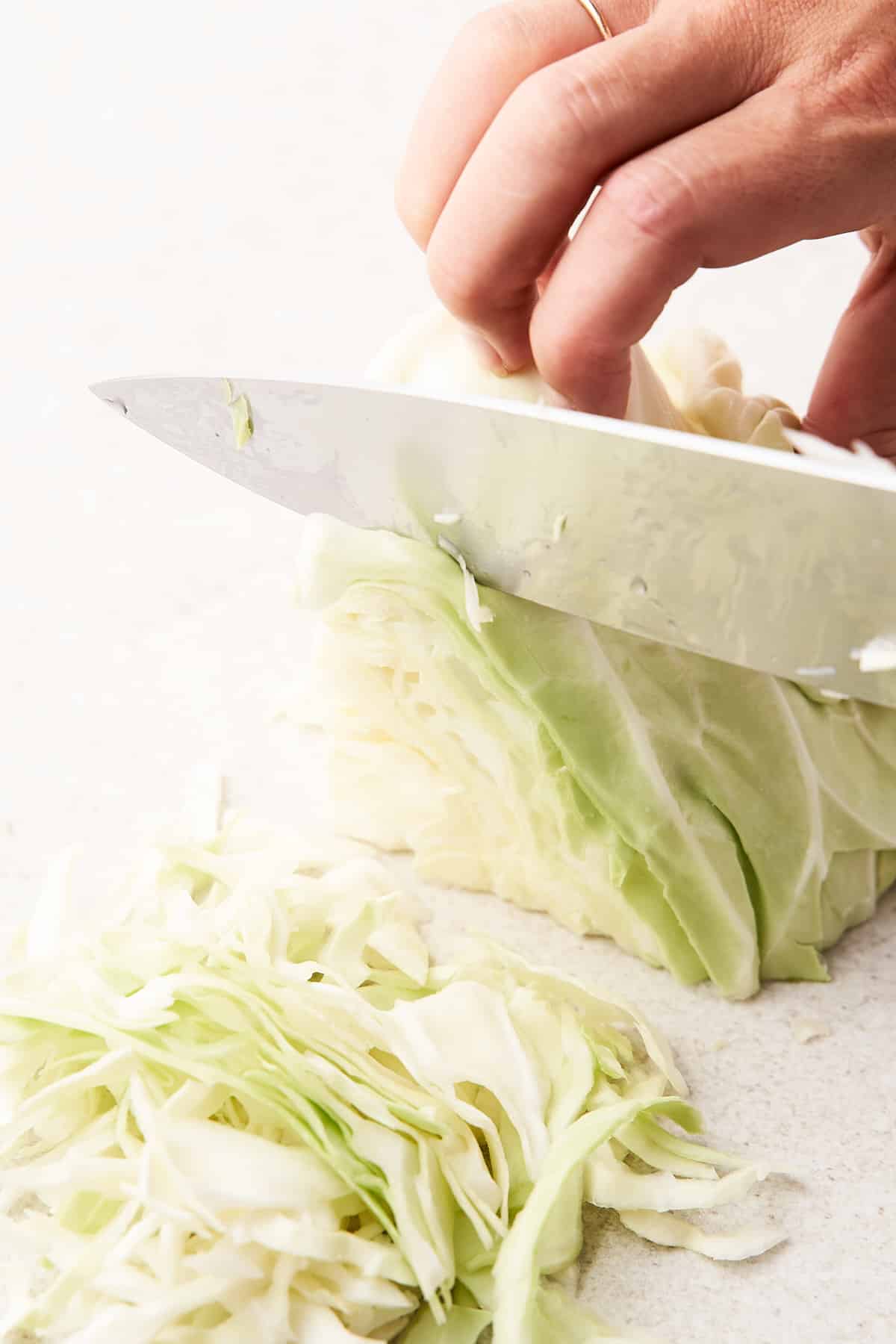
If you own a mandolin, it comes in handy for shredding cabbage. Set your desired thickness, then flip the cabbage flat side down. Move it back and forth across the mandolin blade until you reach the end of the cabbage. Be careful of your fingers as you get closer to the blade! This method is great for our crockpot cabbage.
Tips for cutting cabbage
While the techniques for cutting cabbage are quite simple, just remember the following tips to help keep your fingers extra safe:
- Use a sharp knife: Cabbage is generally quite large and tough to cut through in its raw form. Make sure you have a large chef’s knife and don’t forget to sharpen it before cutting in.
- Cut on a flat side: Prevent the cabbage from wobbling around by doing your best to cut it on a flat side. If the stem end is not very flat when you’re first cutting in, give it a slight trim.
- Use a non-slip board: In addition to cutting on a flat side, make sure to use a heavy non-slip cutting board. If your cutting board is not non-slip, place a damp paper towel underneath the board for better grip.
- Curl your fingers: As with most other fruits and vegetables, make a claw shape with the hand that is gripping the cabbage as you slice it. This will prevent any finger mishaps.
How to pick the perfect cabbage every time
Knowing how to cut cabbage is only half of the equation, but I’d say picking the perfect head is equally important when it comes to delicious-tasting recipes. Here are my go-to tips to keep in mind when you’re at the grocery store:
- Color: Pick cabbage heads that appear vibrant in color. Avoid those with discolorations, bruises, gashes, etc.
- Weight: Look for heads of cabbage that feel heavy for their size.
- Firmness: Choose cabbage with tight, firm leaves.
- Shape: Ensure each vegetable is fairly round and not falling apart.
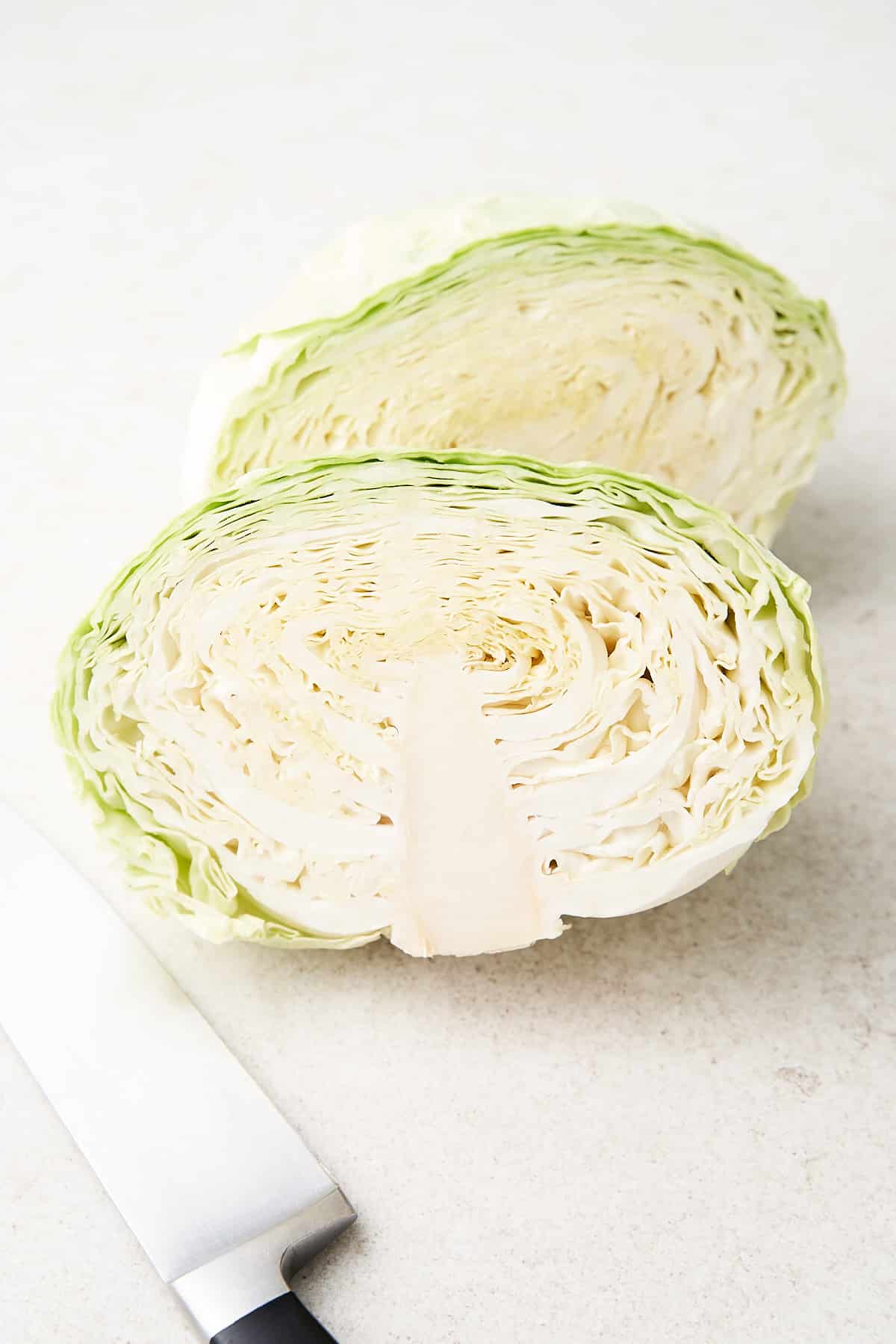
Storing
If you have leftover cabbage, follow these easy storage tips to keep it fresh for longer:
- Fridge: For whole heads of cabbage, it’s best to store them in the crisper drawer in a loose plastic bag or cling wrap. Stored this way, you’ll get about 6-7 days out of them. For cut cabbage, ensure the pieces are completely dry and keep them in an airtight container for 2-3 days. Avoid washing any pieces until you’re ready to use them.
- Freezer: The good news is that you can freeze cabbage whole, in quarters, steaks, or shreds. Just add them to a freezer-safe bag and they will last up to 3-4 months.
How to use cabbage in recipes
Cabbage may not be the first vegetable you reach for, but I think it should be up there with the popular kids! I mean, it can be added to such a wide variety of recipes! Here are just a few to get you started, but this list is by no means exhaustive:
- Thai Cabbage Salad
- Berry Cabbage Smoothie
- Hungarian Unstuffed Cabbage
- Pickled Red Cabbage
- Vegetarian Egg Roll in a Bowl
- Vegan Korean BBQ
- How to Make Sauerkraut
Nutritional benefits
Don’t let the 22 calories in a cup of cabbage fool you. This cruciferous vegetable is packed with vitamins and nutrients:
56% of Daily Vitamin K
Found in abundance in cabbage, vitamin K is a vital component in the clotting process of blood and in building bones.
36% of Daily Vitamin C
While it’s involved in a laundry list of bodily functions, vitamin C is especially necessary for the production of collagen, which gives skin flexibility and structure.
Insoluble Fiber
Insoluble fiber can’t be broken down by our bodies, which in turn keeps our digestion regular and our gut microbiome happy.
Helps with Inflammation
Cruciferous vegetables, like cabbage, contain many antioxidants such as sulforaphane and kaempferol. These antioxidants have been shown to help reduce inflammation in the body.
Cabbage FAQs
While the core (white part) is edible, it’s quite tough. It is recommended to remove it before slicing the cabbage.
Much like a head of lettuce, the outer leaves of a cabbage head are often wilted, dirty, or browning. It’s best to remove the outer layer before cutting the cabbage.
Although you can cut cabbage ahead of time, it’s best to wait until right before you’re going to use it. Cutting a head of cabbage only takes 4-5 minutes, and it will last much longer if it’s stored uncut.
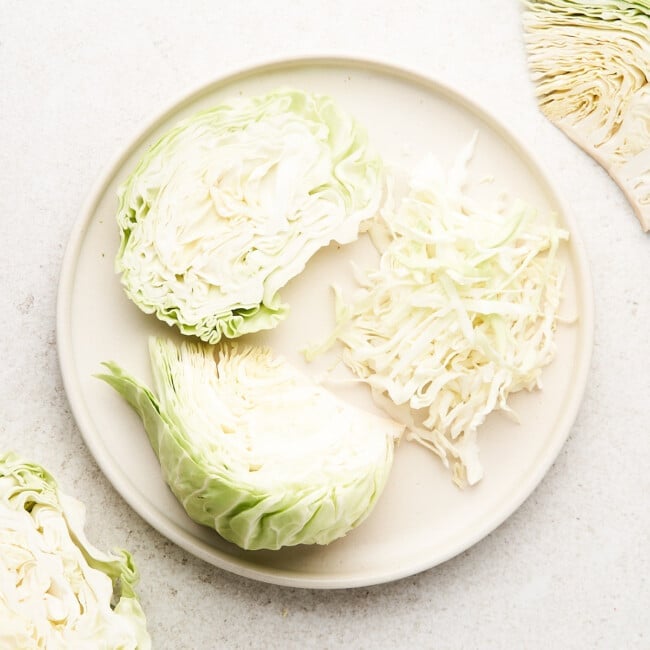
Ingredients
- 1 head cabbage
Instructions
- Remove the outermost leaves from the head of the cabbage, especially if they appear bruised, wilted, or discolored. Give the cabbage a rinse, then dry it thoroughly.
Steaks
- Stand the cabbage upright with the stem side down, making sure it’s not wobbling around. If need be, trim the stem slightly to create a flat surface.
- Firmly grip the cabbage with your non-dominant hand, then make slices about ¾ – 1 inch thick.
Wedges
- Again, stand the cabbage upright with the stem side down. Slice it down the middle into two equal halves. Turn each half over, then slice it in half again to make quarters.
- Note: If your cabbage is large, cut the quarters one more time to make smaller wedges.
- To remove the core, keep each wedge on a flat side. Make an angled cut with your knife, ensuring you don't cut all the way through the core (it will help keep the leaves together).
Shredded
- Repeat the same process as the cabbage wedges. Once you’ve removed the core, make thin perpendicular slices all the way along each cabbage quarter.
- Make the slices fairly thin, around ⅛ – ¼ inch thick for recipes like coleslaw or sauerkraut. For stir-fries and the like, you can cut them around ½-inch thick.
- If you own a mandolin, set your desired thickness and flip the cabbage flat side down. Move it back and forth across the mandolin blade until you reach the end of the cabbage. Be careful of your fingers as you get closer to the blade!
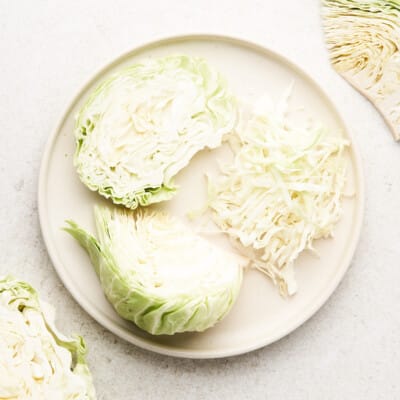



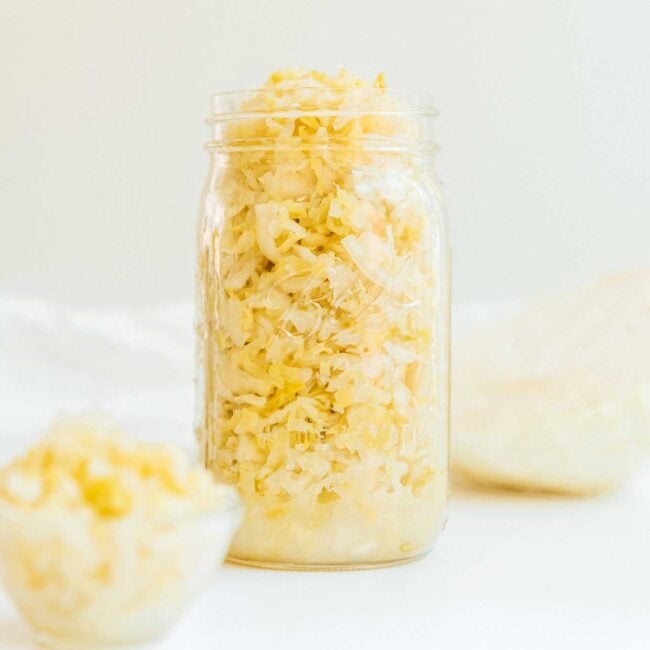
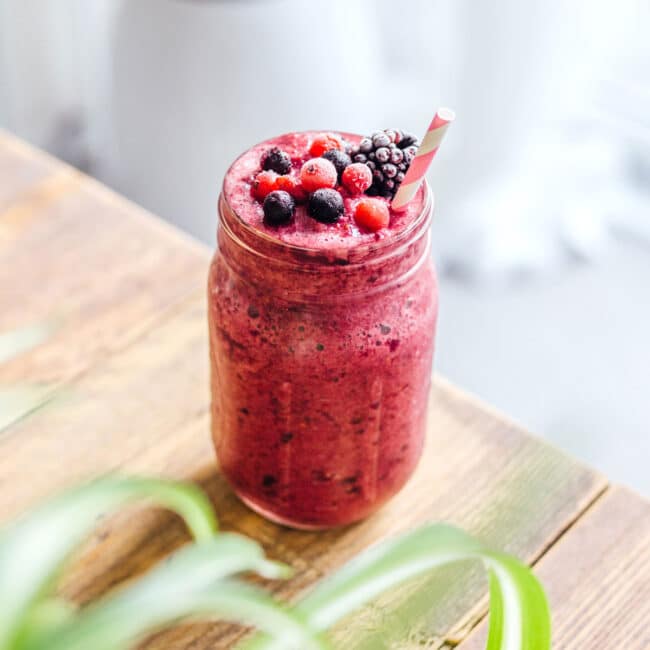


Leave a Comment